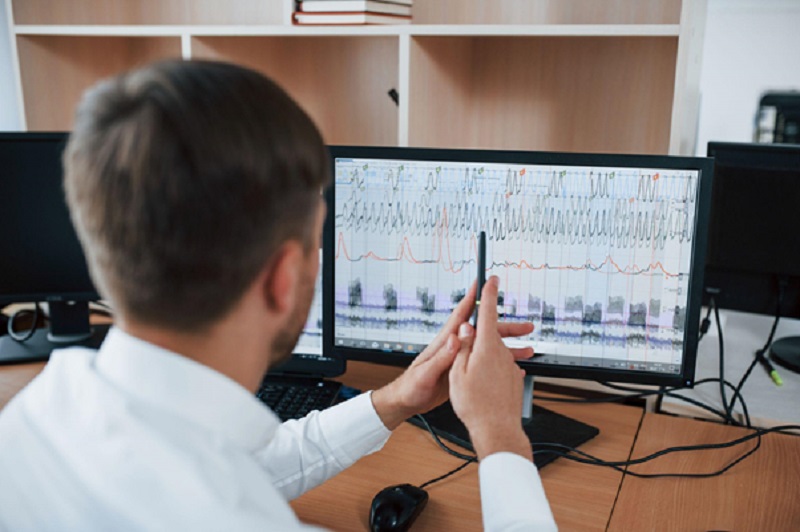Oscilloscopes 101: What They Are and How They Work

An oscilloscope is one of those tools that makes invisible things visible. Electricity may be flowing in a circuit, but unless you are content with a multimeter giving you a single number, you need something that shows the whole picture. That is where this piece of test and measurement equipment comes in. It lets you see voltage dancing over time, drawn as a waveform on the screen.
Unlike meters that show averages, an oscilloscope displays every bump, dip, and flicker. Imagine trying to judge a song by hearing one note. That is what a meter gives you. The oscilloscope plays the whole track, letting you spot the rhythm, tempo, and even the off-key bits.
The Basics of Operation
At its core, the device plots voltage on the vertical axis against time on the horizontal. The result is a moving trace, usually a wavy line. You can stretch or shrink the view using controls for volts per division and time per division. This lets you zoom in on small details or step back for a wider view.
The trigger control helps keep the signal steady. Without it, the waveform would roll endlessly, like trying to read a book in a gale. By locking onto a chosen point, the trigger keeps the display stable. That makes comparing signals easier and keeps headaches at bay.
Probes act as the link between the oscilloscope and the circuit. Standard probes come with settings like ×1 or ×10, which scale the signal and protect the equipment. Correctly connecting probes, with proper grounding, is essential. Skip that, and you risk noise on your trace or worse, a blown component.
Different Types for Different Jobs
Oscilloscopes are not all built the same. The traditional analogue version uses a cathode ray tube to show the waveform in real time. It is simple but limited. Digital storage oscilloscopes, the most common today, sample signals, digitise them, and allow for storage and deeper analysis.
There are also mixed signal models, which combine analogue waveforms with digital logic patterns. This is useful when testing systems where electronic signals and digital communication live side by side. PC-based oscilloscopes connect to a computer, using its processing power and screen for display. They save bench space and can be more portable, though they rely on software to run smoothly.
Each type of oscilloscope counts as part of the wider family of test and measurement equipment, designed for specific scenarios. Engineers pick the right model depending on whether they are chasing a noisy guitar amplifier, diagnosing a car ignition system, or developing circuit boards for medical devices.
Everyday Advantages
One key benefit of using an oscilloscope is troubleshooting. When a signal is not behaving, you can track down glitches, distortions, or drops in voltage that a regular meter would miss. For example, a faulty capacitor might cause dips in the waveform, or a misaligned sensor might show irregular pulses.
The tool also helps in design work. By viewing the full waveform, engineers can tweak circuits for stability and efficiency. Audio specialists use it to monitor sound signals, making sure the waves are clean. In automotive repair, scopes help measure injector currents or ignition signals, making them invaluable in modern garages.
Measuring Beyond Voltage
While voltage is the headline act, current often plays the supporting role. With the right current probe, oscilloscopes can measure how current changes in sync with voltage. This is crucial in power electronics, where the relationship between the two determines efficiency.
Time-based measurements are another advantage. Frequency, duty cycle, and rise time can all be observed. These parameters matter in digital circuits, where timing issues can lead to errors or failed communication. Watching how fast a signal jumps from low to high can reveal if a system is fast enough for its intended job.
Developments and Improvements
Modern oscilloscopes have gone beyond simple waveform displays. Digital models allow saving traces for later analysis, comparing past and present signals, or exporting data for reports. Many offer automatic measurements, taking the legwork out of calculating frequency or peak voltage.
There are also advances in connectivity. Some instruments now link to networks, allowing remote monitoring and data sharing. Engineers working on large projects can store results centrally, making collaboration easier. In labs, software integration means tests can be automated, saving time and reducing repetitive tasks.
Another improvement lies in bandwidth and sampling rates. Higher bandwidth allows the device to capture faster signals without distortion. Increased sampling rates mean more data points per second, giving a clearer and more accurate trace. These features matter in industries like telecoms and aerospace, where precision is non-negotiable.
Why It Matters
Oscilloscopes may seem like specialist tools, but they have a broad role. From classrooms to shipyards, from music studios to hospitals, they keep systems running as they should. When signals misbehave, the oscilloscope provides clarity, helping users track down faults and maintain performance.
In education, they give students hands-on experience with real signals. In research, they provide the data needed to prove ideas. In repair work, they are often the difference between guessing and knowing. Their strength lies in visibility, turning abstract current flow into a clear, understandable picture.
The Next Step
Oscilloscopes remain central in the world of test and measurement equipment because they offer insight you cannot get from simple meters. By showing signals as they are, they help people fix, design, and maintain everything from everyday electronics to complex industrial systems.
If you want to see what your circuits are really saying, an oscilloscope is the tool that speaks their language. Contact Genetron to learn how the right equipment can help you keep your signals in tune.







